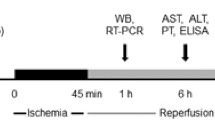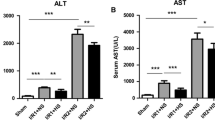Abstract
Overproduction of heat shock protein 70 (HSP70) in the liver protects hepatocytes under various pathologic conditions. In this study we examined the effects of a nontoxic HSP70 inducer, geranylgeranylacetone (GGA), on acute hepatic failure after 95% hepatectomy in rats. When GGA (100 mg/kg) or vehicle was intragastrically administered to rats 4 hours before 95% hepatectomy, all 25 rats pretreated with vehicle died within 60 hours after the operation, whereas 10 of 25 rats pretreated with GGA survived. During the 24-hour postoperative period, GGA significantly suppressed the release of aspartate or alanine aminotransferase and elevation of the serum interleukin-6 level, and completely inhibited an increase in the serum level of tumor necrosis factor-alpha. Histologic examinations showed that GGA prevented hemorrhagic necrosis, which was observed in vehicle-treated livers more than 12 hours after the operation. During the 24-hour postoperative period, HSP70 induction was absent in remnant livers of vehicletreated rats. In contrast, GGA stimulated the HSP70 mRNA expression and HSP70 accumulation within 4 hours, and viable hepatocytes contained abundant HSP70 in their nuclei. Our results suggest that GGA may prevent acute liver failure after massive hepatectomy, at least in part, by enhancing HSP70 induction in the remnant liver.
Similar content being viewed by others

References
Diehl AM, Rai RM. Liver regeneration 3: Regulation of signal transduction during liver regeneration. FASEB J 1996;10:215–227.
Tuczek HV, Rabes H. Verlust der Proliferationsfahigkeit der Hepatozyten nach subtotalen Hepatektomie. Experientia 1971;27:526.
Emond J, Capron-Laudereay M, Meriggi F, Bernuau J, Reynes M, Houssin D. Extent of hepatectomy in the rat: Evaluation of basal condition and effect of therapy. Eur Surg Res 1989;21:251–259.
Fukuchi T, Hirose H, Onitsuka A, Hayashi M, Senga S, Imai N, Shibata M, Yamauchi K, Futamura N, Sumi Y. Effects of portal-systemic shunt following 90% partial hepatectomy in rats. J Surg Res 2000;89:126–131.
Mochida S, Ogata I, Hirata K, Hirata K, Ohta Y, Yamada S, Fujiwara K. Provocation of massive hepatic necrosis by endotoxin after partial hepatectomy in rats. Gastroenterology 1990;99:771–777.
Gallery MP, Mangino MJ, Flye MW. A biological basis for limited Kupffer cell reactivity to portal-derived endotoxin. Surgery 1991;110:221–230.
Wang XD, Soltesz V, Andersson R, Bengmark S. Bacterial translocation in acute liver failure induced by 90% hepatectomy in the rat. Br J Surg 1993;80:66–71.
Calley MP, Kamai T, Flye MW. Kupffer cell tumor necrosis factor-α production is suppressed during liver regeneration. J Surg Res 1991;50:515–519.
Leist M, Gantner F, Bohlinger I, Tiegs G, Germann PG, Wendel A. Tumor necrosis factor-induced hepatocyte apoptosis precedes liver failure in experimental murine shock models. Am J Pathol 1995;146:1220–1234.
Panis Y, McMullan DM, Emond JC. Progresive necrosis after hepatectomy and the pathophysiology of liver failure after massive resection. Surgery 1997;121:142–149.
Andiran F, Ayhan A, Tanyel FC, Abbasoglu O, Sayek I. Regenerative capacities of normal and cirrhotic livers following 70% hepatectomy in rats and the effect of α-tocopherol on cirrhotic regeneration. J Surg Res 2000;89:184–188.
Welch WJ. Mammalian stress response: Cell physiology, structure/function of stress protein, and implications for medicine and disease. Physiol Rev 1992;72:1063–1081.
Minowada G, Welch WJ. Clinical implications of the stress response. J Clin Invest 1995;95:3–12.
Jaattela M. Heat shock proteins as cellular lifeguards. Ann Med 1999;31:261–271.
Saad S, Kanai M, Awane M, Yamamoto Y, Morimoto T, Is-selhard W, Minor T, Troidl H, Ozawa K, Yamaoka Y. Protective effect of heat shock pretreatment with heat shock protein induction before hepatic warm ischemic injury caused by Pringle’s maneuver. Surgery 1995;118:510–516.
Yamagami K, Yamamoto Y, Kume M, Kimoto S, Yama-moto H, Ozaki N, Yamamoto M, Shimahara Y, Yamaoka Y. Heat shock preconditioning ameliorates liver injury following normothermic ischemia-reperfusion in steatotic rat livers. J Surg Res 1998;79:47–53.
Salminen WF Jr, Voellmy R, Roberts SM. Protection against hepatotoxicity by a single dose of amphetamine: The potential role of heat shock protein induction. Toxicol Appl Pharmacol 1997;147:247–258.
Fujimori S, Otaka M, Otani S, Jin M, Okuyama A, Itoh S, Iwabuchi A, Sasahara H, Itoh H, Tashima Y, Masamune O. Induction of a 72-kDa heat shock protein and cytoprotection against thioacetamide-induced liver injury in rats. Dig Dis Sci 1997;42:1987–1994.
Kume M, Yamamoto Y, Saad S, Gomi T, Kimoto S, Shima-bukuro T, Yagi T, Nakagami M, Takeda Y, Morimoto T, Yamaoka Y. Ischemic preconditioning of the rat liver in rats: Implication of heat shock protein induction to increase tolerance of ischemia-reperfusion injury. J Lab Clin Med 1996;128:251–258.
Hirakawa T, Rokutan K, Nikawa T, Kishi K. Geranylgeranylacetone induces heat shock proteins in cultured guinea pig gastric mucosal cells and rat gastric mucosa. Gastroenterology 1996;111:345–357.
Yamagami K, Yamamoto Y, Ishikawa Y, Yonezawa K, Toy-okuni S, Yamaoka Y. Effects of geranyl-geranyl-acetone administration before heat shock preconditioning for conferring tolerance against ischemia-reperfusion injury in rat livers. J Lab Clin Med 2000;135:465–475.
Higgins GM, Anderson RM. Experimental pathology of the liver. I. Restoration of the liver of the white rat following partial surgical removal. Arch Pathol 1931; 12:186–202.
Kubota T, Takabe K, YangM, Sekido H, Endo I, Ichikawa Y, Togo S, Shimada H. Minimum sizes for remnant and transplanted livers in rat. J Hepatobiliary Pancreat Surg 1997;4:398–404.
Gaub J, Iversen J. Rat liver regeneration after 90% partial hepatectomy. Hepatology 1984;4:902–904.
Nishizawa Y, Tanaka H, Kinoshita K. Absorption, distribution, metabolism, and secretion of tetraprenyacetone in rats and guinea pigs. Prog Med 1983;3:1029–1035.
Fudaba Y, Tashiro H, Ohdan H, Miyata Y, Shibata S, Shin-taku S, Nishihara M, Asahara T, Ito H, Fukuda Y, Dohi K. Prevention of warm ischemic injury in rat liver transplantation by geranylgeranylacetone. Transplant Proc 2000; 32:1615–1616.
Ikeyama S, Kusumoto K, Miyake H, Rokutan K, Tashiro S. A non-toxic heat shock protein 70 inducer, geranylgeranylacetone, suppresses apoptosis of cultured rat hepatocytes caused by hydrogen peroxide and ethanol. J Hepatol 2001;35:53–61.
Polla BS, Kantengwa S, Francois D, Salvioli S, Franceschi C, Marsac C, Cossarizza A. Mitochondria are selective targets for the protective effects of heat shock against oxidative injury. Proc Natl Acad Sci USA 1996;93:6458–6463.
Hauser GJ, Dayao EK, Wasserloos K, Pitt BR, Wong HR. HSP induction inhibits iNOS mRNA expression and attenuates hypotension in endotoxin-challenged rats. Am J Physiol 1996;271:2529–2535.
Kim Y-M, de Vera ME, Watkins SC, Billiar TR. Nitric oxide protects cultured rat hepatocytes from tumor necrosis factor-alpha-induced apoptosis by inducing heat shock protein 70 expression. J Biol Chem 1997;272:1402–1411.
Fudaba Y, Tashiro H, Ohdan H, Miyata Y, Shibata S, Shin-taku S, Nishihara M, Asahara T, Ito H, Fukuda Y, Dohi K. Efficacy of HSP72 induction in rat liver by orally administered geranylgeranylacetone. Transpl Int 2000;13:S278-S281.
Rai RM, Yang SQ, McClain C, Karp CL, Klein AS, Diehl AM. Kupffer cell depletion by gadolinium chloride enhances liver regeneration after partial hepatectomy in rats. AmJ Physiol 1996;270:909–918.
Rokutan K, Teshima S, Kawai T, Kawahara T, Kusumoro K, Mizushima T, Kishi K. Geranylgeranylacetone stimulates mucin synthesis in cultured guinea pig gastric pit cells by inducing a neuronal nitric oxide synthase. J Gastroenterol 2000;35:673–681.
Kobayashi N, Fujiwara T, Westerman KA, Inoue Y, Sak-aguchi M, Noguchi H, Miyazaki M, Cai J, Tanaka N, Fox IJ, Leboulch P. Prevention of acute liver failure in rats with reversibly immortalized human hepatocytes. Science 2000; 287:1258–1262.
Rudolph KL, Chang S, Millard M, Schreiber-Agus N, De-Pinho A. Inhibition of experimental liver cirrhosis in mice by teromerase gene delivery. Science 2000;287:1253–1258.
Author information
Authors and Affiliations
Corresponding author
Additional information
Supported by a Grant-in-Aid for Scientific Research (No. 12557105) from the Japanese Ministry of Education, Science and Culture (K.R.).
Rights and permissions
About this article
Cite this article
Oda, H., Miyake, H., Iwata, T. et al. Geranylgeranylacetone suppresses inflammatory responses and improves survival after massive hepatectomy in rats. J Gastrointest Surg 6, 464–473 (2002). https://doi.org/10.1016/S1091-255X(01)00043-9
Issue Date:
DOI: https://doi.org/10.1016/S1091-255X(01)00043-9



